Saturday, March 12, 2005
Silvered Æ antoninianus, Gallienus, Antioch, Göbl 1622b
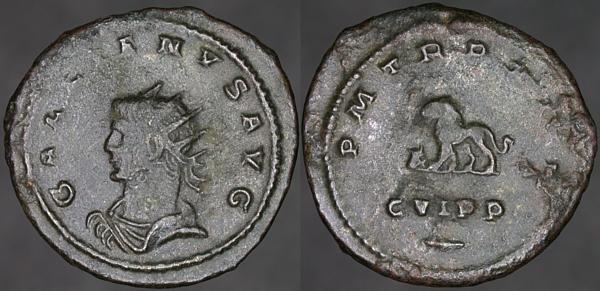
GALLIENVS AVG, Radiate draped cuirassed bust left | P M TR P XIII, Lion walking left toward bucranium. C VI P P over branch in exergue.
I've previously posted coins with this reverse and other busts here and here, and covered what I know of the significance of the reverse design. Antioch's left-facing draped cuirassed is one of my favorites busts, if one of the least often seen.
Friday, March 11, 2005
Æ26, Dacia, Valerian, Sear GIC 4417var
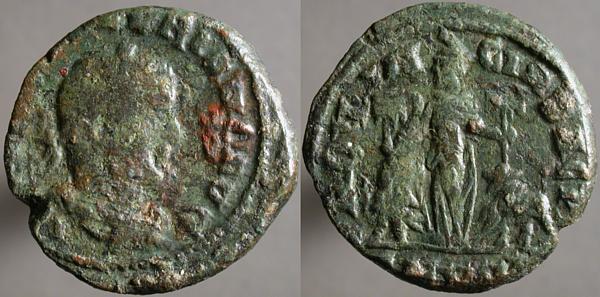
[IMP P LIC V]ALERIANO AVG, Laureate draped bust right | PROV_IN_CIA DACI[A], Dacia standing facing, head left, holding standards, with eagle holding wreath and bull at their bases. AN VIII in exergue.
The provincial coinage of Dacia is clearly related to that of nearby Viminacium, though the fine details of that relationship remain open to debate.
A good page on the coinage can be found here.
Thursday, March 10, 2005
Æ as, Mariniana, Rome, Göbl 224f
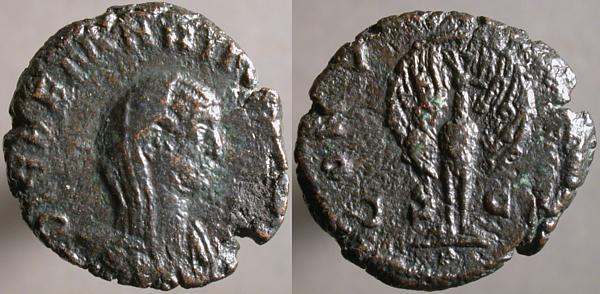
DIVAE MARINIANAE, Veiled draped bust right | CONSECRATIO, Peacock standing facing, tail erect, head right, S_C across fields. Q in exergue.
In December 2003, I posted a similar, better preserved coin distinguished from this primarily by a diadem that Mariniana wears in addition to the veil.
Mariniana was the wife of Valerian, and appears on the coinage only deified, after her death. Presumably her death preceeded her husband's becoming emperor. I don't know if she was Gallienus's mother, or if she was a subsequent wife of his father.
Wednesday, March 09, 2005
AR denarius, Q. Pomponius Musa, Roman republic, 66 BCE, Crawford 410/9b
AR denarius, Q. Pomponius Musa, Roman republic, 66 BCE, Crawford 410/9b
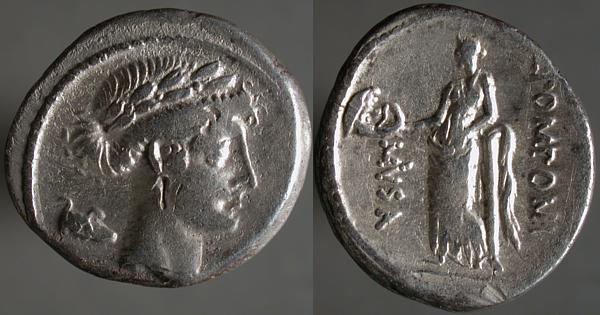
Laureate head of Apollo right, sandal behind | Thalia standing left holding comic mask left, leaning on column right. Q.POMPONI right, MVSA left.
In 66 BCE the moneyor Q. Pomponius Musa minted a series of coins each featuring one of the nine muses or Hercules as their leader. This was a pun on his name, Musa. The Romans loved this sort of stuff (Greeks did too).
Thalia was the Muse of comedy and characteristically holds one of the pair of masks that are today more familiar than the Muses themselves.

Laureate head of Apollo right, sandal behind | Thalia standing left holding comic mask left, leaning on column right. Q.POMPONI right, MVSA left.
In 66 BCE the moneyor Q. Pomponius Musa minted a series of coins each featuring one of the nine muses or Hercules as their leader. This was a pun on his name, Musa. The Romans loved this sort of stuff (Greeks did too).
Thalia was the Muse of comedy and characteristically holds one of the pair of masks that are today more familiar than the Muses themselves.
Tuesday, March 08, 2005
Æ31, Tarsus in Cilicia, Valerian, Lindgren III 933
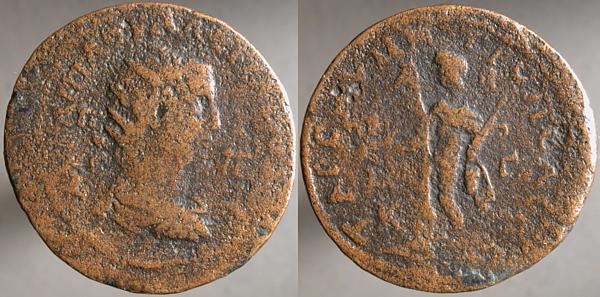
AV KAI ΠOV Λ[I O]VAΛE[PIANONC CE], Radiate draped cuirassed bust right, Π before and behind | TAPC MH_TPOΠOΛ[EΩC], Perseus standing left, holding statue of Apollo with two wolves left, harpa and Medusa's head right. A / M / K in left field, Γ / Γ in right.
A coin that's suffered much wear after it was minted and, apparently, a badly broken reverse die when it was made. The "object" just to the left of Perseus is a die break extending across nearly the entire diameter of the coin.
Tarsus favored images from mythology or, I suspect, images of then well-known statues showing scenes from mythology.
Monday, March 07, 2005
Æ antoninianus, Gallienus, Rome, Göbl 388o
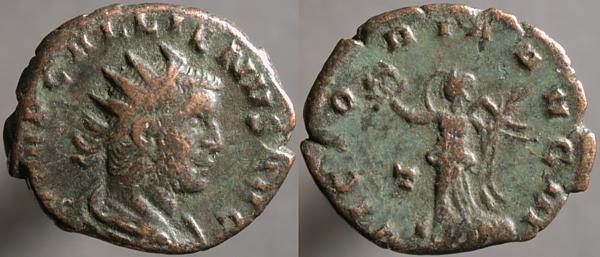
IMP GALLIENVS AVG, Radiate draped cuirassed bust right | VICTORIA AVG III, Victory advancing left, raising wreath left, holding palm right. T in left field.
Not a bust that's attested for this reverse by Göbl, but it is attested for other coins of this period and, by itself, raises no suspicion.
The reverse celebrates Gallienus's third victory. Interpretation of that numbering is the subject of Andreas Alfoldi's The Numbering of the Victories of the Emperor Gallienus and of the Loyalty of his Legions, a short monograph with a long title.
Sunday, March 06, 2005
Æ tetradrachm, Alexandria, Salonina, Emmett 3846(15)

KOPNHΛIA CAΛωNEINA CEB, Diademed draped bust right | LIE,
Another example that's taken some damage since it was minted, in 268 CE, it shows Eirene, Greek goddess of peace, the model for the Roman Pax. She's seen holding an olive branch, which is her attribute and still our shorthand for peace in newspaper headlines and political cartoons.
10/25/07: Keith Emmett has corrected me that this is, in fact, Alexandria, not Eirene. Alexandria was the tutelary spirit of that city.

